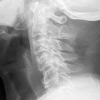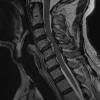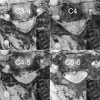Nontraumatic acute paraplegia associated with cervical disk herniation
- PMID: 21061902
- PMCID: PMC2964031
- DOI: 10.1080/10790268.2010.11689721
Nontraumatic acute paraplegia associated with cervical disk herniation
Abstract
Background: Acute paraplegia is a true emergency. It is often the result of trauma but is rarely reported in association with cervical disk herniation in patients without antecedent injury.
Methods: Case report.
Findings: This 75-year-old man presented with acute paraplegia due to severe compression of the spinal cord by herniation of the C4-C5 cervical disk. He underwent emergency diskectomy and anterior fusion. Postoperatively, his neurologic functions improved gradually.
Conclusions: Cervical disk herniation should be considered in the differential diagnosis of nontraumatic acute paraplegia. Pre-existing narrowed canal is an important predisposing factor and excessive neck movements are believed to be triggering factors. Immediate early decompressive surgery is recommended to avoid irreversible progression of neurologic deficit.
Figures




Similar articles
-
Nontraumatic acute complete paraplegia resulting from cervical disc herniation: a case report.Spine (Phila Pa 1976). 2003 Mar 15;28(6):E125-8. doi: 10.1097/01.BRS.0000050404.11654.9F. Spine (Phila Pa 1976). 2003. PMID: 12642777
-
Non-traumatic acute paraplegia associated with cervical disc herniation: a case report.Surg Neurol. 1999 Aug;52(2):204-6; discussion 206-7. doi: 10.1016/s0090-3019(97)00422-9. Surg Neurol. 1999. PMID: 10447291
-
Anterior transcorporeal approach of percutaneous endoscopic cervical discectomy for disc herniation at the C4-C5 levels: a technical note.Spine J. 2016 May;16(5):659-66. doi: 10.1016/j.spinee.2016.01.187. Epub 2016 Feb 2. Spine J. 2016. PMID: 26850173
-
Nontraumatic cervical disc herniation in a 21-year-old patient with no other underlying disease.Neurol Med Chir (Tokyo). 2012;52(9):652-6. doi: 10.2176/nmc.52.652. Neurol Med Chir (Tokyo). 2012. PMID: 23006880 Review.
-
Thoracic disc herniation, cord compression, and paraplegia caused by electrical injury: case report and review of the literature.J Trauma. 1994 Aug;37(2):328-32. doi: 10.1097/00005373-199408000-00028. J Trauma. 1994. PMID: 8064936 Review.
Cited by
-
Paraplegia after gastrectomy in a patient with cervical disc herniation: a case report and review of literature.Case Rep Anesthesiol. 2014;2014:718690. doi: 10.1155/2014/718690. Epub 2014 Mar 18. Case Rep Anesthesiol. 2014. PMID: 24757571 Free PMC article.
-
Acute spontaneous cervical disc herniation causing rapidly progressive myelopathy in a patient with comorbid ossified posterior longitudinal ligament: Case report and literature review.Surg Neurol Int. 2014 Aug 28;5(Suppl 7):S368-72. doi: 10.4103/2152-7806.139671. eCollection 2014. Surg Neurol Int. 2014. PMID: 25289163 Free PMC article.
-
Spinal cord infarction at the level of ossification of the posterior longitudinal ligament.Spinal Cord Ser Cases. 2016 Nov 24;2:16032. doi: 10.1038/scsandc.2016.32. eCollection 2016. Spinal Cord Ser Cases. 2016. PMID: 28053773 Free PMC article.
-
Acute Cervical Disk Herniation Resulting in Sudden and Severe Neurologic Deterioration: A Case Series.Surg J (N Y). 2016 Sep 17;2(3):e96-e101. doi: 10.1055/s-0036-1593357. eCollection 2016 Jul. Surg J (N Y). 2016. PMID: 28824999 Free PMC article.
-
Delayed spinal cord infarction following anterior cervical surgical decompression.BMJ Case Rep. 2017 Oct 9;2017:bcr2017219863. doi: 10.1136/bcr-2017-219863. BMJ Case Rep. 2017. PMID: 28993348 Free PMC article.
References
-
- Kyriakides AE, Lalam RK, El Masry WS. Acute spontaneous spinal subdural hematoma presenting as paraplegia: a rare case. Spine. (Phila Pa 1976) 2007;32(21):E619–E622. - PubMed
-
- Rathore MF, Gill ZA, Malik AA, Farooq F. Acute flaccid paraplegia: a rare complication of meningococcal meningitis. Spinal Cord. 2008;46(4):314–316. - PubMed
-
- Huang MK, Chen CC, Wang TL, Lee YK, Su YC. Simultaneous bilateral femoral arterial emboli presenting with acute paraplegia: an uncommon case. Am J Emerg Med. 2009;27(6):753.e3–4. - PubMed
-
- Lourie H, Shende MC, Stewart DH., Jr The syndrome of central cervical soft disk herniation. JAMA. 1973;226(3):302–305. - PubMed
-
- Ueyama T, Tamaki N, Kondoh T, Miyamoto H, Akiyama H, Nagashima T. Non-traumatic acute paraplegia associated with cervical disk herniation: a case report. Surg Neurol. 1999;52(2):204–206; discussion 206–207. - PubMed
Publication types
MeSH terms
LinkOut - more resources
Full Text Sources
Medical
Miscellaneous
